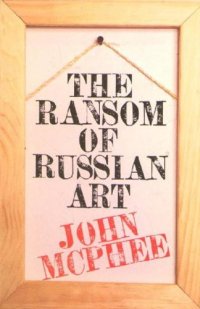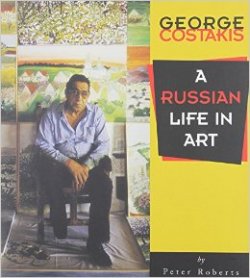Review of “The Ransom of Russian Art,” by John McPhee, and “George Costakis: A Russian Life in Art,” by Peter Roberts

These two books, like many dates I’ve been on lately, are complementary halves of what I really want. If I could only get the best qualities of each into one unit, I’d have perfect love. As it is, one of them is completely sexy but what would we say to each other in the morning, while the other is so bright and generous and smart and right in every way but just not a bit attractive.
John McPhee is a writer, and that’s a help if you want to produce books; his story of Norton Dodge, surely the most avid American collector of Russian art, is funny, quick, sometimes lyrical, and written in an irresistible tone of glorious revelation. Unfortunately McPhee seems to have little understanding of what Russia was or is like, or of how artistic activity there has differed from parallel activity in the West. Dodge’s encyclopedic holdings include some of the most important work produced in the former Soviet Union from the ’50s to the ’70s, but they also include a fiesta of kitschy rubbish, and Dodge has resolutely refused to allow a queue of hungry curators to grab the good stuff and torch the rest. Perhaps that is his gift — perhaps the buying meant more than the work; perhaps the fact of independent painting in the Soviet Union meant more than many individual paintings themselves do. Dodge’s American Cold War sensibility, infused with unfocused genius and generosity of spirit, enabled the preservation of artistic movements conceived partly in opposition to that sensibility. McPhee understands none of this; he affects Dodge’s bravado and makes a fool of himself. Where Dodge is brave, eccentric, and electrifying in his extravagant innocence and sometime brilliance, McPhee is simply oblivious. He pretends to contextualize Dodge, but he hasn’t done enough research, and what we have is a highly readable anecdotal description of a remarkable man — all very well in its way, but not much of a book.
Peter Roberts, on the other hand, understands everything, and his book on George Costakis, another collector of Russian art, reveals the depth of his knowledge without trumpeting it. Roberts is a career diplomat (his Canadian nationalism can wear thin, but one forgives him); he must have been dazzling in his work, for his cross-cultural empathy is unparalleled, and the austere intelligence of his analysis, of both art and politics, creates the bridge between those two subjects that has eluded so many from the East and the West. Roberts never puts a foot wrong, and acknowledges and shapes himself to every subtlety of his narrative. Sadly, however, his book seems never to have met the editor’s pencil: some of it is hardly in English, and it has as tiresome a structure as the old politburo. It repeats itself endlessly and tediously, and Robert is so overawed by his subject that he has transcribed entire interviews, providing the popular reader with the sort of archival information that belongs by rights in a vault in a Texas university.

Much has been written about the art that was produced in the territories of the old Soviet Union during that 70-year experiment between the Bolshevik revolution and glasnost; and it is arguable that the courage, vision, and integrity of artists from Kasimir Malevich to Ilya Kabakov have no counterpart in the West. For many of these artists, simply lifting a paintbrush was a revolutionary gesture, and ultimately a dangerous one. Little has been written until now about the people who collected that work, though their behavior was in its own way equally revolutionary and equally dangerous; and without them all the artists’ genius would now have faded into rumor. Both Dodge and Costakis collected not out of materialism and ambition, but out of spirit and valor, and so their work as collectors is itself a kind of art activity. It is gratifying to see this subject being tackled at last.
The timing of these books seems chillingly apt at a moment when efforts to destroy the National Endowment for the Arts reinforce one’s sense of a systematic devaluation of art in this country. As the U.S. government forsakes art, as museum budgets tighten, as taxpayer money settles elsewhere, we will increasingly need to find individuals who can give without regard for financial or social profit, who will see collecting as occasion for adventure and high-minded loyalty (as Dodge did), or who will dispense with their own comfort because they think art matters more (as Costakis did). The fact of their support will perhaps come to mean as much as what they support. The heroism of artists comes and goes and is part of the poetry of their ways, but the heroism of collectors has never been needed in the modern West so much as it will be in a post-NEA United States. Who will these new collectors be? The Russians who collected Russian art in the Soviet period were unable to acquire on any great scale; the significant patronage came from outside. (Dodge is American; Costakis was Greek.) If those patrons’ equals are to be found in this new era in American arts, they, too, will likely come from someplace else — Russia, perhaps, where there’s now too much new money and nothing worth spending it on and a burgeoning cultural trend toward gallantry that could find expression in saving the art of a fallen civilization.











